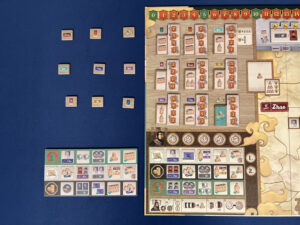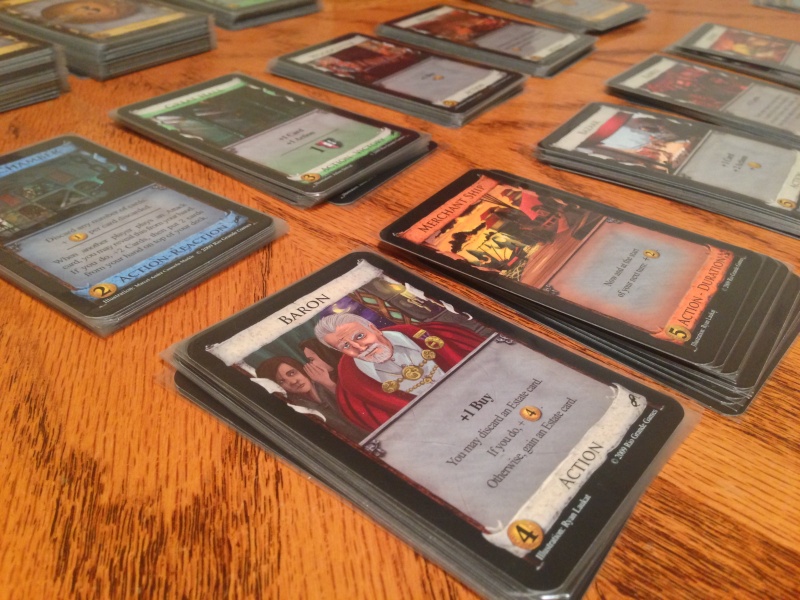 Reinventing and reimagining a game that others deem as a classic must be one of the hardest tasks a developer/designer could undertake. And yet, even so, this monstrous feat has been successfully achieved many times recently. In my opinion, the most notable return of a game was tweaking Brass and turning it into Brass: Birmingham. Somehow, Gavan Brown and his team at Roxley took what was an already iterated-upon title and twisted it into the #1 game on BoardGameGeek. So, how successful were Marco Canetta and Stefania Niccolini at remaking Zhanguo into Zhanguo: The First Empire?
Reinventing and reimagining a game that others deem as a classic must be one of the hardest tasks a developer/designer could undertake. And yet, even so, this monstrous feat has been successfully achieved many times recently. In my opinion, the most notable return of a game was tweaking Brass and turning it into Brass: Birmingham. Somehow, Gavan Brown and his team at Roxley took what was an already iterated-upon title and twisted it into the #1 game on BoardGameGeek. So, how successful were Marco Canetta and Stefania Niccolini at remaking Zhanguo into Zhanguo: The First Empire?
Gameplay Overview:
In Zhanguo: The First Empire, players will be competing in various tasks for victory points. What players will be doing for said points is Building Walls (paying certain resources to unlock multiplicative scoring opportunities), Constructing the Mausoleum (racing one another to meet certain conditions first for higher victory points), and Appointing Governors (most in each region at the end of the game gets a nice chunk of points).

What makes all of these monumental tasks doable in so few turns is through tableau building. At the start of each round, players will be getting six cards dealt to them from three different decks. With those cards, players can either take an action or lay a card down into their tableau. When a card is laid down, the actions shown at the top of the card indicate which action will be amplified. If I were to take a Build Walls action in the future and there’s a card with that symbol in my tableau, then I get to do what the other half of that card says, which could even be another action.
Here’s what ties it all together: Those cards you get at the start of your turn are numbered from 1-120, with each deck being separated into increments of 40. When you go to take an action (instead of laying a card in your tableau) you must play a card from your hand into the Court. The number of the card and the placement in the Court of your chosen action dictate if your bonuses in your tableau will activate: if the card you play is a higher value and you chose an action on the right, then your bonuses trigger. If you do not get this aligned properly, your tableau bonuses sit unactivated.

Game Experience:
Zhanguo: The First Empire is one of the nicest productions for a retail game I’ve seen in years. Maybe even ever? The shipping cardboard insert at the bottom of the box is divided up into wells with labels so you know where pieces are supposed to go. The meeples are of all different shapes, and they’re screen printed. Even the Unrest Cubes have lightning bolts on them, a completely unnecessary touch. What I love most is that this game is multi-textured. Board gaming is a physical medium, and being able to handle cards, cardboard, and wood is nice, especially when it’s all high quality.

And thankfully, I can say with much enthusiasm, the quality of the game matches the quality of the components. I have always loved eurogames, and ironically, Brass: Birmingham was one of the first ones I played when I was getting back into the hobby. What makes Brass: Birmingham shine over Brass: Lancashire (the original version of the game) is its ability to present options into a tight system without losing any of the tension, and its ability to welcome new players without boring any seasoned ones. I feel that Zhanguo: The First Empire accomplishes both of those points too.
I don’t have the time to break down every little change between editions, but the main two that make the game so much more accessible are the Alchemist cards and the Elixir route. The Alchemist cards are a set of five cards each player starts with that are separate from the six drawn at the start of every round. When certain game conditions happen, players get to play one of the cards into their tableau, and these cards are powerful. The absolute genius behind these cards is that yes, they are powerful, but they are situationally powerful. They aren’t cards to base an entire strategy around, they are cards that are there to save players who have built a lopsided engine due to inexperience or poor card draw.

The Elixir route introduces an entirely new action into the game. This, first and foremost, finally balances out the Court actions to be even between left and right, making the ping-pong number play more even, as well as making it engaged with more frequently. That route also gives players more options to score more points and gives more resources out. This makes each and every action in the game much richer, literally, but also figuratively, as players can do some really wild Eurogame shenanigans with several powerful actions in one turn much easier now.
The other way that this game greatly improves over the original is the variability of the game. Nearly each and every way that this game could be changed up between plays has the pieces to back that option up. Not only does the order of the cards and the players around the table dictate how unique each game will be, but now the requirements and rewards get shaken up in ways weird and wonderful each time too.

Final Thoughts:
If you’re a modern Eurogame lover who appreciates amazing production, cherishes tried-and-true designs, and appreciates cruel yet indirect player interaction, go buy this game. You will not regret it. If you’re a player of the original version of Zhanguo, take a personal inventory. If you want nicer components and a changing board state, go for it. Be warned, though, that in the opinion of this curmudgeon, Zhanguo: The First Empire does not simply replace Zhanguo, as the introduced systems can obscure the crueler, more area-controlled focused original.
Final Score: 4 Stars – Another euro classic has been granted a new life and a beautiful coat of paint, on its insides and outsides.
 Hits:
Hits:
• Proven and revered for a decade
• New features bring new life
• Astonishing retail-focused production design
Misses:
• Can be cruel for Eurogamers
• Random card draw ruins plans
• Taste dictates which title’s preferred






















